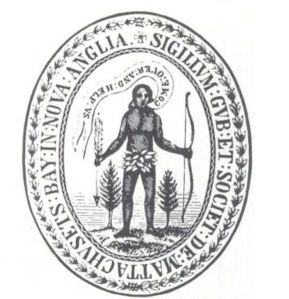The seal of the Massachusetts Bay Colony shows a Native American man standing between two evergreen trees. He is naked except for a loincloth of leaves, and he’s holding a bow in one hand and arrows pointing down (signifying peace) in the other. From his mouth emerges a scroll, bearing the words “Come over and help us,” an allusion to Acts 16:9, which records the Apostle Paul having a vision in which he saw a man begging him: “Come over into Macedonia and help us.”
It seems a strange image for a colony of Puritans whose primary reason for settling in New England was freedom from religious persecution. It suggests that there were other, perhaps equally significant, motivations. It also betrays an acute awareness that the land they were “coming over to” was already occupied.
Though the seal portrays a native asking for help, there’s no evidence that the native Algonquian people of New England ever felt the need for English help, let alone that they begged for it. So the seal is clearly not based on historical events.
An obvious conclusion is that the seal reflects the Puritans’ missionary zeal. But, in fact, they didn’t make much effort to convert the natives for more than a decade, even then, it was largely the efforts of one man: John Eliot, the minister at Roxbury. And his labors were only marginally successful.
Why, then, was this image chosen to represent the colony? Why not a seal showing the colonist’s connection to the wealth and power of England? Why not one representing the resources available in the new world?
The simple answer is that the seal was a public relations tactic, and its purpose was economic. To understand this, we need to look at what was going on in England. The great migration of Puritans from England to Massachusetts Bay Colony started in 1630. The Puritans were able to raise money to support their migration to New England, by promising great economic benefits for their investors.
But, when the civil war in England resulted in Oliver Cromwell’s rise to power, many Puritans decided to go back. That left those who stayed concerned about financial backing. It was at this point that the emphasis shifted from religious freedom to converting the natives. It wasn’t an all-out effort, but it got attention – and funds. To the English investor, it appeared to be a worthy Christian endeavor, with obvious economic benefits. If the natives could be “helped” by being converted to Christianity and integrated into English society, then their land and resources would come with them.
The money poured in and John Eliot began his ventures into Nipmuc territory to proselytize and baptize. Massachusetts Bay Colony had an image to seal the deal.


